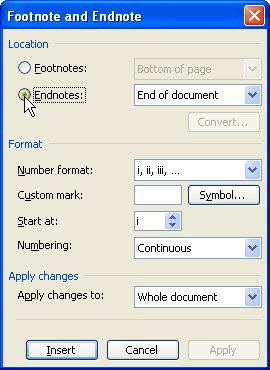Please Note: This article is written for users of the following Microsoft Word versions: 97, 2000, 2002, and 2003. If you are using a later version (Word 2007 or later), this tip may not work for you. For a version of this tip written specifically for later versions of Word, click here: Adding Information after the Endnotes.
Written by Allen Wyatt (last updated March 10, 2018)
This tip applies to Word 97, 2000, 2002, and 2003
Linda knows how to add endnotes to the end of a document. What she wants to do, however, is to add a page after the endnotes in order to add additional references that need to be included with her document.
The way to do this is fairly simple in Word. By default, endnotes are placed at the end of the document in which they occur. You can, however, specify where you want endnotes to appear. You have two choices: end of the document (the default) and end of the section.
What this means is that you can add a next page section break after the end of your document's body, and then add to the new section (the part after the section break) the information you want after the endnotes. Then, follow these steps if you are using Word 97 or Word 2000:
If you are using Word 2002 or Word 2003, follow these steps:

Figure 1. The Footnote and Endnote dialog box.
After this change, the endnotes should appear just before the section break, and right before the additional reference items needed in the document.
WordTips is your source for cost-effective Microsoft Word training. (Microsoft Word is the most popular word processing software in the world.) This tip (513) applies to Microsoft Word 97, 2000, 2002, and 2003. You can find a version of this tip for the ribbon interface of Word (Word 2007 and later) here: Adding Information after the Endnotes.

Learning Made Easy! Quickly teach yourself how to format, publish, and share your content using Word 2021 or Microsoft 365. With Step by Step, you set the pace, building and practicing the skills you need, just when you need them! Check out Microsoft Word Step by Step today!
Word makes it easy to convert all your footnotes to endnotes and vice versa. You may want to only convert a couple of ...
Discover MoreWhen multiple endnote references are used at a given point in your document, you may wonder if there is a way to compress ...
Discover MoreMost footnotes in a document start numbering with the number 1 and proceed from there through the rest of your document. ...
Discover MoreFREE SERVICE: Get tips like this every week in WordTips, a free productivity newsletter. Enter your address and click "Subscribe."
There are currently no comments for this tip. (Be the first to leave your comment—just use the simple form above!)
Got a version of Word that uses the menu interface (Word 97, Word 2000, Word 2002, or Word 2003)? This site is for you! If you use a later version of Word, visit our WordTips site focusing on the ribbon interface.
Visit the WordTips channel on YouTube
FREE SERVICE: Get tips like this every week in WordTips, a free productivity newsletter. Enter your address and click "Subscribe."
Copyright © 2025 Sharon Parq Associates, Inc.
Comments